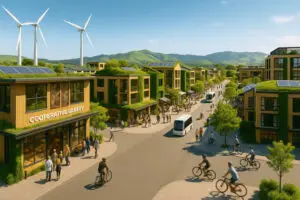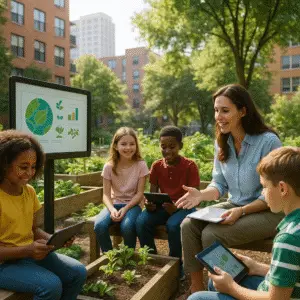Automation Sustainable Development Tech
Automation Sustainable Development Tech
Automation Sustainable Development Tech is rapidly reshaping sustainable urban development across Australia. By integrating artificial intelligence (AI), real-time data, and smart infrastructure, cities can now reduce emissions, optimise energy, and respond faster to climate threats. From Sydney’s digital twin models to Auckland’s urban tree mapping via AI, the region is embracing tech-forward solutions to meet future challenges.
Green infrastructure like living rooftops and smart irrigation systems are being paired with digital technologies to maximise environmental gains. These advances are not theoretical—Australian government projects already reflect this evolution. The NSW Spatial Digital Twin enables better disaster response and planning decisions, while Auckland’s Ngahere AI boosts biodiversity outcomes using aerial data analytics.
Through AI-driven predictive analytics and automation, urban planners can test scenarios before investing, enhance public safety, and ensure cities remain resilient to extreme weather events. Crucially, this approach supports both ecological integrity and community wellbeing—making automation a key enabler of greener, more liveable cities across Australasia.
Learn how key concepts like green infrastructure, predictive modelling, and intelligent city systems are merging in the next wave of urban sustainability🔸 Automation: The Digital Backbone of Green Cities
Automation in sustainable urban development means using technology to streamline infrastructure. Smart traffic systems, autonomous building controls, and AI-based energy management help reduce waste and emissions. By 2025, over 500 global cities will use digital twins powered by real-time data to optimise urban operations. In Australia, Sydney’s digital twin integrates transport, emissions, and weather data—providing vital insights for proactive city management.
🔸 Green Infrastructure Gets Smarter
Traditional green spaces like trees and parks now come embedded with technology. In Auckland, a drone-assisted AI system maps tree canopy to guide reforestation efforts—achieving over 96% accuracy. Smart irrigation systems also cut water use by monitoring soil and weather, an approach already trialled in Melbourne. These “intelligent ecosystems” strengthen climate resilience while cutting costs and labour.
External Reference: Green by Nature – Urban Ecology Innovations
🔸 Predictive Climate Analytics
AI enables cities to forecast floods, heatwaves, and pollution spikes with remarkable accuracy. In NSW, predictive models simulate bushfire risks, allowing targeted safety upgrades. Similarly, New Zealand’s weather services are using AI to improve air quality forecasting. By identifying hotspots before crises occur, these systems save lives and reduce infrastructure damage.
External Reference: ICLEI Australia – Smart Climate Tools
🔸 AI in Urban Planning: Generative & Assistive Design
Generative AI tools now help city designers explore new layouts quickly. In 2024, students in Philadelphia used AI to redesign traffic corridors into linear parks. Australian planners are applying similar models to simulate wind, noise, and heat conditions—evaluating how design impacts liveability before any construction begins. This “AI-human collaboration” enhances creativity while reducing project risk. Automation Sustainable Development Tech.
🔸 Key Benefits
Energy Efficiency: AI-driven HVAC systems and smart grids lower consumption.
Resilience: Forecasting tools allow for earlier response to weather or disaster events.
Better Planning: Digital twins help simulate before building.
Liveability: Cleaner air, quieter streets, greener spaces.
🔸 Challenges and Ethical Considerations
Privacy & Security: More sensors mean more data—privacy protocols are essential.
Bias & Fairness: AI models must be transparent and auditable.
Costs & Skills: Smaller councils need funding and talent to keep pace.
Australia is addressing these with frameworks like the NSW AI Assurance Framework, which outlines responsible AI use in government.
🔸 Future Outlook
Expect deeper integration of automation in city planning, driven by:
Renewable-powered AI infrastructure
Real-time optimisation of energy, transport, and water systems
Wider rollout of digital twins and “eco-digital” city models
Cities like Sydney, Brisbane, and Wellington are already acting as regional leaders. With the right policies, AI and automation can scale equitably—delivering low-carbon, high-performance urban life across Australia and beyond.
Technical

Short Long Term Profit Tech
Short Long Term Profit Tech describes the gap between rapid gains and durable value; closing that gap is central to sound policy, finance, and corporate strategy. Infrastructure: the cost of deferred upkeep Short Long Term Profit Tech The 2007 collapse of Minneapolis’s I-35W bridge shows how chasing short-term savings can

Global Insights Green Tech
Global Insights Green Tech Infrastructure research reveals that urban sustainability advances fastest when cities treat climate solutions as shared intellectual capital rather than proprietary assets. The cross-regional exchange, for instance, of green infrastructure policies—from Copenhagen’s storm-water “sponge” parks to Vancouver’s low-carbon mobility—lets planners skip trial-and-error and move directly to scalable,

Education Strategies Tech
Education Strategies Tech in Sustainable Development Education strategies tech plays a central role in driving sustainable development in Australia. As communities face urgent climate and ecological challenges, educational efforts ensure that people are both informed and engaged. Notably, outreach is no longer confined to schools—it spans apps, public media, and